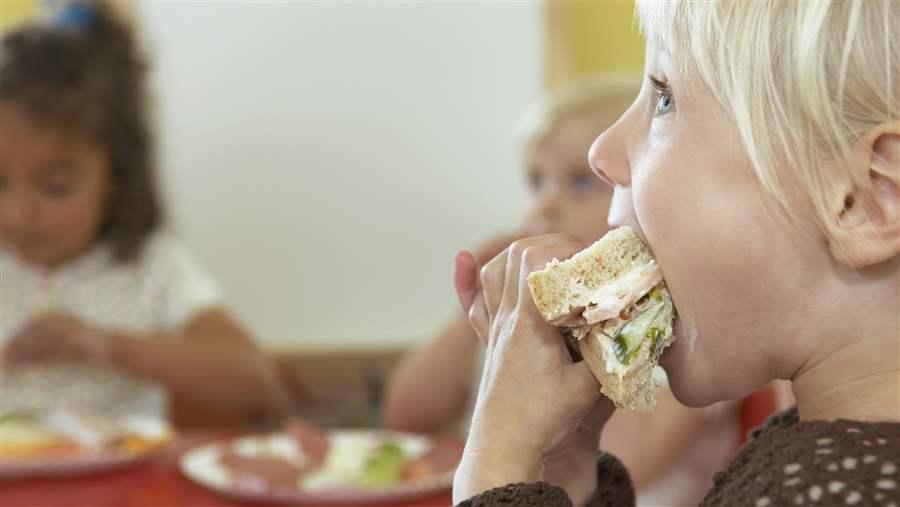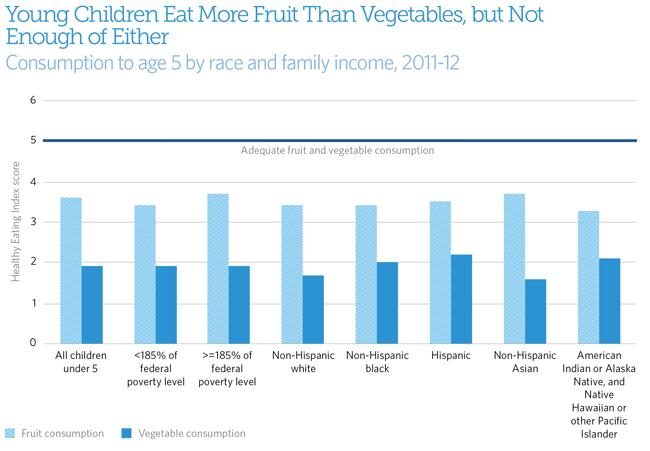4 Million Kids in Early Care and Education Settings Will Soon Get Healthier Foods
New standards will improve nutrition; providers can maximize benefits by adopting best practices

The Child and Adult Care Food Program plays a critical role as a federal nutrition safety net for low-income children and families who are at risk of unreliable access to healthy food.
© Beau Lark/Getty ImagesUpdates to a federal nutrition program for children in early care and education (ECE) settings will mean healthier meals and snacks for millions of kids across the country without substantial cost increases for providers, according to a new report on the impact of the changes and strategies for successful implementation that is being released in time for National Childhood Obesity Awareness Month.
Each day, more than 4 million kids, many from low-income families, receive meals and snacks for which providers are reimbursed through the Child and Adult Care Food Program (CACFP), which provides funding to ECE sites, as well as after-school and adult day care institutions. Through the program, the U.S. Department of Agriculture aims to ensure that all of these vulnerable populations have daily access to nutritious foods. This fall, the USDA will implement a rule updating the nutrition standards for CACFP, the first such change in nearly 50 years. To be eligible for reimbursement, meals and snacks now must contain a greater variety of vegetables, including those that are dark green, red, and orange, and fewer grain-based desserts, such as cakes and cookies. The changes also require more whole grains and less added sugar and saturated fat. The study found that once the changes are implemented, the program will better meet enrolled children’s nutritional needs while having only minimal effects on provider costs.
The report—written by researchers with the Kids’ Safe and Healthful Foods Project, a collaboration between The Pew Charitable Trusts and the Robert Wood Johnson Foundation—captures the findings of a health impact assessment (HIA) that was undertaken to predict how the changes to CACFP’s nutrition standards might affect the overall health of children up to age 5 who are served by the program in centers and family child care homes. HIAs bring together research, health expertise, and stakeholder input to identify the potential and often overlooked health effects of proposed laws, regulations, projects, policies, and programs.
Changes will improve children’s diets, even many not served by CACFP
The assessment concluded that some of the new standards, such as updated requirements for whole grains, fruits, and vegetables, will translate into health benefits for children. For example:
- The nutritional quality of CACFP-funded meals and snacks should improve under the new standards, increasing enrolled children’s intake of whole grains and vegetables, decreasing their consumption of grain-based desserts, and having a positive overall impact on their health. The changes are especially important because young children in the United States typically do not eat enough whole grains, fruit, or vegetables and consume too much fat, salt, and added sugar.
- Revising menus to meet the updated nutrition standards will require some providers to serve foods that may be unfamiliar to them or the populations they serve, but once the changes are made, attitudes about healthy foods among early care and education providers, enrolled children, and parents could improve. As a provider explained to the researchers, “We want parents to look to us as a role model and understand, ‘This is what healthy eating looks like, and I can do this at home.’” And a parent confirmed, “I definitely took a cue from the school, and instead of asking my daughter what she wants to eat for dinner, I just put healthy foods on the table.
- The new standards may also have ripple effects on the diets of children who are not served by CACFP, because all children under the care of a provider that follows CACFP standards would probably receive the more nutritious meals and snacks, regardless of their eligibility for reimbursement. Moreover, many states’ child care licensing requirements adhere to CACFP standards, even for providers that do not participate in the program.
Strategies for successful implementation
After a phased-in implementation, providers are required to be in full compliance with the updated standards by Oct. 1. According to the report, strategies that can help providers successfully serve nutritious meals and snacks that meet the standards include:
- Securing buy-in from teachers, staff, and administrators and communicating with parents about menu changes. Providers who actively support positive attitudes toward nutritious foods among parents and children are more likely to have success encouraging children to eat and enjoy those foods. Providers can consider strategies like taste-testing or garden projects and can communicate with parents about changes to the foods being served; for example, by sending menus and recipes home with children, inviting parents to taste-testing events, and including families in school garden projects.
- Using resources such as the Rainbow in My Tummy database of CACFP-compliant menus, the Minute Menu tracking tool, portable receipt scanners, and spreadsheet software to plan menus and document what is served.
- Finding opportunities to lower costs, such as through bulk collaborative purchasing with other providers; buying produce in season or from local farms, markets, or co-ops; and adding vegetarian options. The USDA, state agencies, and sponsors can help keep providers’ costs down by negotiating prices with distributors and retailers, and/or making subsidized memberships to warehouse or wholesale stores available to providers. This is especially important because the assessment found that the changes to the nutrition standards may result in some provider cost increases.
Stephanie Scarmo leads and Sallyann Bergh contributes to research on school nutrition programs and policies for the Kids’ Safe and Healthful Foods Project, a collaboration between The Pew Charitable Trusts and the Robert Wood Johnson Foundation.


Healthier Nutrition Standards Benefit Kids
A health impact assessment of the Child and Adult Care Food Program’s updated rules for meals and snacks


Nutrition Standards Can Improve Children’s Health
A review of the literature on meal and snack nutrition standard updates







